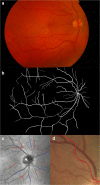Retinal biomarkers for Alzheimer's disease and vascular cognitive impairment and dementia (VCID): implication for early diagnosis and prognosis
- PMID: 33011937
- PMCID: PMC7732888
- DOI: 10.1007/s11357-020-00252-7
Retinal biomarkers for Alzheimer's disease and vascular cognitive impairment and dementia (VCID): implication for early diagnosis and prognosis
Abstract
Cognitive impairment and dementia are major medical, social, and economic public health issues worldwide with significant implications for life quality in older adults. The leading causes are Alzheimer's disease (AD) and vascular cognitive impairment/dementia (VCID). In both conditions, pathological alterations of the cerebral microcirculation play a critical pathogenic role. Currently, the main pathological biomarkers of AD-β-amyloid peptide and hyperphosphorylated tau proteins-are detected either through cerebrospinal fluid (CSF) or PET examination. Nevertheless, given that they are invasive and expensive procedures, their availability is limited. Being part of the central nervous system, the retina offers a unique and easy method to study both neurodegenerative disorders and cerebral small vessel diseases in vivo. Over the past few decades, a number of novel approaches in retinal imaging have been developed that may allow physicians and researchers to gain insights into the genesis and progression of cerebromicrovascular pathologies. Optical coherence tomography (OCT), OCT angiography, fundus photography, and dynamic vessel analyzer (DVA) are new imaging methods providing quantitative assessment of retinal structural and vascular indicators-such as thickness of the inner retinal layers, retinal vessel density, foveal avascular zone area, tortuosity and fractal dimension of retinal vessels, and microvascular dysfunction-for cognitive impairment and dementia. Should further studies need to be conducted, these retinal alterations may prove to be useful biomarkers for screening and monitoring dementia progression in clinical routine. In this review, we seek to highlight recent findings and current knowledge regarding the application of retinal biomarkers in dementia assessment.
Keywords: Alzheimer’s disease; Dementia; OCT angiography; Retinal biomarkers; Retinal imaging.
Conflict of interest statement
The authors declare that they have no competing interests.
Figures








Similar articles
-
Optical coherence tomography and angiography in Alzheimer's disease and other cognitive disorders.Eur J Ophthalmol. 2023 Jul;33(4):1706-1717. doi: 10.1177/11206721221148952. Epub 2023 Jan 9. Eur J Ophthalmol. 2023. PMID: 36617984
-
Advances in retina imaging as potential biomarkers for early diagnosis of Alzheimer's disease.Transl Neurodegener. 2021 Feb 1;10(1):6. doi: 10.1186/s40035-021-00230-9. Transl Neurodegener. 2021. PMID: 33517891 Free PMC article. Review.
-
Imaging retinal microvascular manifestations of carotid artery disease in older adults: from diagnosis of ocular complications to understanding microvascular contributions to cognitive impairment.Geroscience. 2021 Aug;43(4):1703-1723. doi: 10.1007/s11357-021-00392-4. Epub 2021 Jun 8. Geroscience. 2021. PMID: 34100219 Free PMC article. Review.
-
Non-Invasive Retinal Biomarkers for Early Diagnosis of Alzheimer's Disease.Biomedicines. 2025 Jan 24;13(2):283. doi: 10.3390/biomedicines13020283. Biomedicines. 2025. PMID: 40002697 Free PMC article. Review.
-
Retinal microvascular attenuation in mental cognitive impairment and Alzheimer's disease by optical coherence tomography angiography.Acta Ophthalmol. 2020 Sep;98(6):e781-e787. doi: 10.1111/aos.14381. Epub 2020 Mar 9. Acta Ophthalmol. 2020. PMID: 32153141
Cited by
-
Retinal imaging and Alzheimer's disease: a future powered by Artificial Intelligence.Graefes Arch Clin Exp Ophthalmol. 2024 Aug;262(8):2389-2401. doi: 10.1007/s00417-024-06394-0. Epub 2024 Feb 15. Graefes Arch Clin Exp Ophthalmol. 2024. PMID: 38358524 Review.
-
Exploring the Effect of Enbrel Softgels on PWI Indicators in VCIND Patients.J Healthc Eng. 2022 Apr 6;2022:9681235. doi: 10.1155/2022/9681235. eCollection 2022. J Healthc Eng. 2022. Retraction in: J Healthc Eng. 2023 Sep 20;2023:9849835. doi: 10.1155/2023/9849835. PMID: 35432839 Free PMC article. Retracted.
-
Dynamic retinal vessel analysis: flickering a light into the brain.Front Aging Neurosci. 2025 Jan 6;16:1517368. doi: 10.3389/fnagi.2024.1517368. eCollection 2024. Front Aging Neurosci. 2025. PMID: 39834618 Free PMC article. Review.
-
Neurovascular coupling impairment as a mechanism for cognitive deficits in COVID-19.Brain Commun. 2024 Mar 7;6(2):fcae080. doi: 10.1093/braincomms/fcae080. eCollection 2024. Brain Commun. 2024. PMID: 38495306 Free PMC article. Review.
-
Increased Susceptibility to Cerebral Microhemorrhages Is Associated With Imaging Signs of Microvascular Degeneration in the Retina in an Insulin-Like Growth Factor 1 Deficient Mouse Model of Accelerated Aging.Front Aging Neurosci. 2022 Mar 9;14:788296. doi: 10.3389/fnagi.2022.788296. eCollection 2022. Front Aging Neurosci. 2022. PMID: 35356301 Free PMC article.
References
-
- 2020 Alzheimer’s disease facts and figures. Alzheimers Dement. 2020. - PubMed
-
- Liesz A. The vascular side of Alzheimer’s disease. Science. 2019;365:223–224. - PubMed
-
- Dubois B, Feldman HH, Jacova C, Hampel H, Molinuevo JL, Blennow K, DeKosky ST, Gauthier S, Selkoe D, Bateman R, Cappa S, Crutch S, Engelborghs S, Frisoni GB, Fox NC, Galasko D, Habert MO, Jicha GA, Nordberg A, Pasquier F, Rabinovici G, Robert P, Rowe C, Salloway S, Sarazin M, Epelbaum S, de Souza LC, Vellas B, Visser PJ, Schneider L, Stern Y, Scheltens P, Cummings JL. Advancing research diagnostic criteria for Alzheimer’s disease: the IWG-2 criteria. Lancet Neurol. 2014;13:614–629. - PubMed
-
- Budson AE, Solomon PR. New diagnostic criteria for Alzheimer’s disease and mild cognitive impairment for the practical neurologist. Pract Neurol. 2012;12:88–96. - PubMed
Publication types
MeSH terms
Substances
Grants and funding
LinkOut - more resources
Full Text Sources
Other Literature Sources
Medical
Miscellaneous

